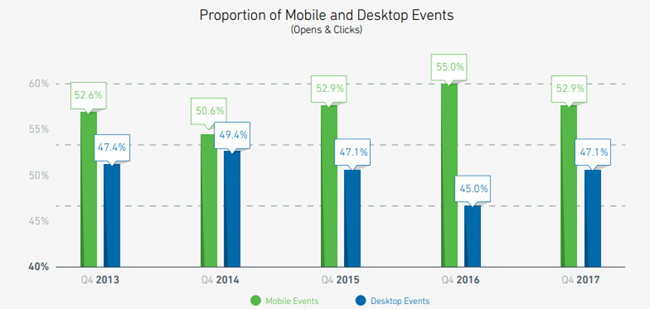Many Businesses are Asking Themselves: "Is Email Dead"?
By Gabriella Pirrone
June 12, 2018
Agile Marketing, B2B Content Marketing, B2B Marketing, content marketing, conversational marketing, Digital Marketing, E-mail Marketing, inbound marketing, marketing, marketing automation, Mobile Commerce
There’s said to be a popular misconception among businesses that keeps surfacing time and time again which in turn is generating a common question among many businesses: Is email dead?
In 2017 alone, email generated more than 50 times its return on investment, but is this the case for 2018 and beyond?
 I read a report by Yes Lifecycle Marketing entitled “Email Benchmark Report: A Marketer’s Guide to 2018”. The report was based on an analysis of almost 9 billion emails sent in Q4 2017 and over 30 billion sent in 2017 which will hopefully help marketers focus on concrete, achievable goals to set in 2018 in order to grow revenue and stay attuned to their audience’s preferences and behaviors.
I read a report by Yes Lifecycle Marketing entitled “Email Benchmark Report: A Marketer’s Guide to 2018”. The report was based on an analysis of almost 9 billion emails sent in Q4 2017 and over 30 billion sent in 2017 which will hopefully help marketers focus on concrete, achievable goals to set in 2018 in order to grow revenue and stay attuned to their audience’s preferences and behaviors.
“Often time’s marketers struggle to see the value in email because they don’t see how the traditional marketing channel can play into their larger marketing initiatives. However, email is still relevant and marketers who are willing to invest in digital-forward strategies will still find email marketing to be effective - they just need to give it an upgrade and discover new ways to approach it; like marketing automation. In fact, companies that use email marketing automation to nurture their contacts see a 451% increase in qualified leads.”
I won’t go into too much detail because the report was fairly large and complex so instead I will highlight the top 6 areas for opportunity that every marketer should have on their radar as mentioned in the report:
Implement Responsive Design 100% of the Time
A couple months back, I had written an article on B2B Mobile Commerce and I came across this interesting fact: in an official Google statement, more than 50% of search queries globally now come from mobile devices. So of course, this section in the report really caught my attention as I’m always interested to hear statistics on desktop vs mobile opens when it comes to email marketing.
“With mobile opens and clicks making up 53% of all email events over the last two years, email adoption on mobile has plateaued. Mobile events (opens & clicks) overtook desktop ones as early as 2013 and since then that ratio has remained the same, implying that adoption of mobile email has reached a saturation point.”

When it came down to a responsive design, it came as no surprise that both desktop and mobile click-to-open (CTO) rates are highest for brands that only send responsive messages. This means that responsive design of course enhances a mobile user's experience but also when viewing on desktop, this is especially important because consumers typically switch between platforms when interacting with emails.
Here are a few interesting statistics from this section of the report when it comes to responsive design:
- While brands that optimize all of their messages enjoy a minimum of 13.1% CTO, the ones sending only non-responsive emails garner significantly lower CTO at 9.7%. In other words, marketers who are yet to optimize their messages only capture 75% of the engagement generated by their responsive counterparts, thus missing out on significant opportunities for conversion.
- Remarkably, marketers who send a mix of responsive and non-responsive messages generate the lowest overall open rates which implies that a consistent experience is key to capturing and maintaining subscribers’ attention.
- At the same time, less than a quarter (24%) of marketers have optimized all of their messages to be responsive, and therefore enjoy higher open and click rates.
Equalize Desktop and Mobile AOV
The key here is to close the gap between mobile and desktop AOV (average order value) and to continually improve the mobile shopping experience. One important purchase driver for big ticket items is having the necessary information easily available and accessible. Often customers get put off to click the ‘purchase’ button on their mobile device because they often times think they are missing something they would probably not overlook if they were looking at it on a larger screen which means consumers believe that desktop functionality can better validate larger purchases.
By providing access to critical product information marketers can encourage consumers to make a purchase decision on their mobile. This often starts with an optimized email, but continues with a consistently seamless experience on a brand’s website or mobile app.
Practice Purposeful Marketing Through Triggers and Value Added Communications
It’s become apparent that the number of active emails continue to grow. The report even stated that in Q4 2017 that increase was up 18% YoY (since Q4 2016). On the other hand, the number of opens and clicks per subscriber is also growing but at a considerably slower pace which tells me that the engagement is not keeping up with the amount of volume.
In Q4, a fifth of brands’ mailable audience was made up of subscribers whose last open was over a year ago. That constitutes a 22.5% YoY increase in inactive subscribers
These two metrics suggest that marketers failed to engage subscribers consistently and that consumers have become less likely to opt into email programs they’re not already subscribed to. These findings present a great opportunity for marketers to improve in 2018 by:
- Improving the relevance of their communications in order to prevent both new and existing subscribers from falling into inactivity.
- Providing compelling reasons for consumers to opt into their email programs and remain engaged in order to grow the size of their audience as well as its engaged segment
Expand Lifecycle and Behavior-Based Triggers
This is where you want to ‘strike when the iron is hot’ and get more ROI from your email campaigns. Trigger emails are exactly what they sound like – automated emails that are triggered based on specific events, such as an action taken (or not) by a website visitor, or a meaningful change in a customer's behavior or profile.
The report used an example that they saw in Q4, anniversary campaigns (messages that acknowledge a milestone in the relationship between a brand and its customer) garnered a 32% higher open rate, 45% higher CTO rate, and almost double the click and conversion rates of standard campaigns. That is not only a massive increase in engagement, but also in revenue.
According to the report “On average, just 2% of email volume in 2017 came from triggers, demonstrating continuously low trigger adoption despite excellent engagement and conversion metrics.”
Equalize Engagement Between Messages with Offers and Those Without
The most common way to utilize engagement is to offer free shipping, specific percent or dollar discount, buy one/get one free etc. in the subject line. In the report, the most popular type of offer was ‘% off’ which accounted for over half (54%) of all offers promoted in email subject lines in 2017.
However and perhaps due to its ubiquity, ‘% off’ is the lowest converter among emails with offers in the subject line.

As shown in the image above, loyalty offers are the best converters with 10.8% of clicks resulting in a purchase. This stands to reason, considering that loyalty offers are typically sent to members of a brand’s rewards program so that audience segment tends to be more engaged and invested.
Although, having said that, it was interesting to see both engagement and conversion is set by standard emails that do not contain any offers in the subject line. Those emails drive considerably higher engagement than messages with offers; in fact, they generate 35% higher open rate, 50% higher CTO and double the unique click rate. At the same time, however, standard messages generate an average conversion rate of just 2% while emails with offers garner an 8.4% conversion rate.

Close the Engagement Gap Between Themed and Non-Themed Emails to Drive Revenue
Think of a themed email that you would send out on or around Christmas,Valentine’s Day, Black Friday, summer, the Super Bowl or any other special holiday – this is your time to shine and really stand out to drive customer engagement. Although, many companies think that incorporating a holiday or event within your email will help bring brand awareness, which is true, but you need to have a truly integrated approach when doing so.
As stated in the report:
“So, even though themed campaigns tend to drive better conversion rates than their non-themed counterparts, there is a great opportunity for marketers to improve their bottom line even more. A higher number of opens generally leads to a higher number of clicks, which leads to a higher number of purchases, ultimately generating more revenue. In short, an incremental increase in clicks for themed emails, given their high conversion rate, can mean sizeable revenue growth.
One of the main culprits is that when marketers use themes, they do not necessarily try to connect their brand to their customers through the theme. Instead, the use of themes becomes a defacto decision with little real relevance to their customers. Without that connection, consumers will quickly move on to the next message in their overflowing inbox without engaging."
Ending Notes
Often time’s marketers have a negative connotation towards email marketing when in reality it can positively impact a company's ROI and qualified leads.
In the end, there are a lot of opportunities for marketers to improve their email initiatives in 2018 and to significantly increase their email-driven revenue. I would highly recommend downloading the report yourself and comparing it to your 2017 data to develop winning tactics for your marketing plan in 2018 and beyond.

Gabriella Pirrone
Gabriella is the Digital Marketing Assistant for CMSC Media. She brings a wealth of knowledge from not only a CMS perspective but also content, SEO and eCommerce. She enjoys everything social media and staying ontop of the latest trends in the digital marketing world.